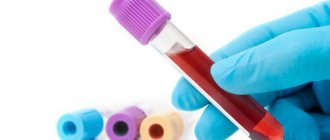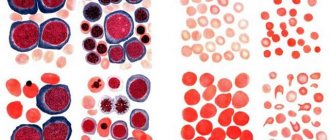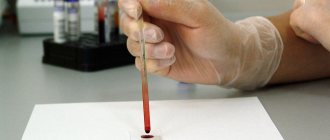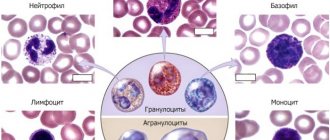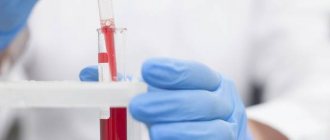What is “good” and “bad” cholesterol
Lipoproteins, molecules consisting of fat and protein, are responsible for transporting cholesterol through the orgasm. They are divided into two types:
High density is “good” cholesterol . It is transferred from the body's cells to the liver, where it is successfully broken down. This cholesterol is believed to prevent cardiovascular disease.
Low density - “bad” cholesterol . Such lipoproteins, on the contrary, transfer cholesterol from the liver to other body systems. If there is too much of it, it is deposited on the walls of blood vessels and forms plaques.
Changes in cholesterol standards by age in women
Differences in metabolism and the functioning of body systems at each stage of life also affect cholesterol levels. Over the years, due to a slowdown in metabolism, it inevitably increases. Changing total cholesterol averages for women:
- up to 5 years: from 2.90 to 5.18 mmol/l;
- 5-10 years: from 2.26 to 5.30 mmol/l;
- 10-15 years: from 3.21 to 5.20 mmol/l;
- 15-25 years: from 3.10-5.5 mmol/l;
- 25-35 years: from 3.37 to 5.96 mmol/l;
- 35-40 years: from 3.63 to 6.27 mmol/l;
- 40-50 years: from 3.81 to 6.53 mmol/l;
- 50-60 years: from 4.45 to 7.77 mmol/l;
- 60-70 years: from 4.45 to 7.69 mmol/l;
- 70 years or more: from 4.48 to 7.25 mmol/l.
A significant increase in the upper limit of indicators in women over 60 years of age is explained by the decline of ovarian function. During this period, the risk of obesity, type 2 diabetes, cardiovascular diseases, and osteoporosis increases.
Why do you need to lower cholesterol?
Reducing cholesterol levels is necessary to prevent diseases that can be caused by its excess. Such diseases include:
- atherosclerosis, in which the lumens of the arteries narrow or become blocked;
- coronary heart disease;
- myocardial infarction - death of the heart muscle, provoked by the fact that a coronary artery thrombus blocked the access of blood and oxygen;
- angina - insufficient blood supply to the heart muscle with discomfort or pain in the chest;
- strokes caused by the death of brain cells due to blockage of blood vessels by a blood clot and interruption of oxygen supply.
Cholesterol: lowering cannot be increasing
Do you know why Americans are considered aggressive and assertive? Their blood cholesterol levels are on average significantly lower than those of Europeans. Scientists are already clear: the zeal that we show on the fronts of the war against cholesterol is unnecessary and sometimes even harmful. It's time to reconsider the strategy and tactics of the cholesterol wars!
GUILTY, BUT NOT VERY GUILTY
A recent statement from doctors sounds sensational: there is no direct connection between high cholesterol levels and cardiovascular diseases!
Doubts about this have always existed, but in the late 90s unexpected research data appeared. It turned out that lowering cholesterol with the help of powerful drugs - statins, reduces the risk of cardiovascular diseases only at first, when its level drops by 10-20%. Then no matter what you do, the risk no longer decreases. Some scientists even suggest that the positive effect is achieved not at all by lowering cholesterol, but due to other effects that statins have.
There are already many such studies. It turns out to be a paradoxical situation: just yesterday we were called upon to suppress cholesterol by all possible means, almost to the level of a rabbit (the norm for rodents is 50 mg/dL, for humans – 200 mg/dL).
There is no point in reducing blood cholesterol levels by more than 20%.
Cholesterol is just one of the risk factors for atherosclerosis, although it is the most important. Observational data show: the higher the average cholesterol in a population, the higher the incidence of cardiovascular diseases. High cholesterol.
SEARCHING FOR THE ENEMY
If you lower cholesterol, this does not mean that you are thereby fighting atherosclerosis. A bear, for example, has a normal cholesterol level that is 2 times higher than a human, and atherosclerosis, however, is not the most common disease among clubfoot.
It is not the cholesterol in the blood that is dangerous, but the cholesterol that settles on the walls of blood vessels, forming plaques. Especially in combination with other lipid metabolism disorders: high levels of triglycerides in the blood or low levels of cholesterol carriers - high-density lipoproteins (HDL). Each of these disorders provokes atherosclerosis.
It makes no sense to fight cholesterol as such and get too carried away with this war. The body cannot exist without cholesterol - it is its building material. All cellular structures and tissues of the brain contain cholesterol; it is the precursor of all steroid hormones; without it, the central nervous system cannot function.
But you still need to try to maintain its level within the normal range. In most cases, this can be achieved with diet. Doctors agreed to consider 5.2 mmol/l (200 mg/dl) as the norm. For most, this figure is a dream: the average cholesterol level among Russians is 240 mg/dl.
The cholesterol level is 5.2 mmol/l (200 mg/dl).
WE CARRY OUT EXPLORATION
The only way to find out how high your cholesterol levels are is with a blood test. It is advisable for men to have it done for the first time at the age of 35-40, especially if there are additional risk factors - smoking, diabetes, hypertension (but excess weight is considered not such an important factor). Women are advised to have their cholesterol levels checked as they approach menopause.
Can you trust the analysis? Not long ago, experts assessed the accuracy of determining blood lipids in the laboratories of regular clinics. It turned out that 80% of them make large errors. Therefore, it is better to contact laboratories certified by the All-Russian Certification Center.
There is another way: ask what method is used to determine cholesterol levels in the laboratory - if it is enzymatic, then you can assume that the analysis will be quite accurate. But keep in mind that this method is expensive, and therefore you will have to pay for it. The biggest doubts should arise from free tests: they are performed using the most ancient, cheapest and most inaccurate method.
INCREASED CHOLESTEROL
So, you know your blood cholesterol level and now you must decide whether you need to change something in your life or not.
If your cholesterol level is 240-250 mg/dL (or 6 mmol/L), it's worth considering whether you're eating right. Especially if you have other risk factors for heart disease. However, there is no need to take emergency measures.
If the cholesterol level is 280-300 mg/dl (7-7.5 mmol/l), you need to take decisive action. But under no circumstances should you reach for medications – after all, in principle, you are still quite healthy. To stay that way, it is vital to change your lifestyle: move more, eat less and watch what you eat. You need to monitor your results monthly for the first 2-4 months to assess the effectiveness of your diet.
HOW TO LOWER CHOLESTEROL CHOLESTEROL DIET
- No sandwiches. Try to sharply reduce your butter consumption, ideally switch to vegetable oil. This one step can often bring your cholesterol levels to an acceptable level of 240 mg/dL in just 2-4 weeks.
- Soy instead of cheese. It would also be good to give up cream, sour cream, fatty cheeses and eggs, and at the same time quit smoking. Switching to soy products is very beneficial. This is a protein diet that helps fight excess weight and replaces cholesterol-containing concentrated dairy products.
- Lard lovers should remember that it is very rich in cholesterol. Its consumption must be compensated by eating vegetable oil and fatty fish. It is good to eat lard with garlic: it helps to utilize fats faster.
- Maintain a balance of fats - saturated (animal), monounsaturated and polyunsaturated - there should be a third of them in the diet. In other words, every “eaten piece” of animal fat must be compensated with vegetable fats. You can do this: mix olive, sunflower (or corn) and soybean oils in equal parts and add this balanced mixture to salads, cereals and pasta. DIET FOR HIGH CHOLESTEROL
Walnuts do not help lower cholesterol!
* If there is little HDL (high-density lipoprotein that carries cholesterol) in the blood, substances contained in red grapes will help increase their levels. This is the effect that data on the benefits of moderate consumption of red wine is based on - but juice is also quite suitable!
* If your HDL cholesterol is more than 300-320 mg/dL (8-10 mmol/L) cholesterol, it is better not to try to cope with the problem on your own. A doctor must understand the reasons for such a serious violation.
If dietary cholesterol is to blame, the only thing that will help is diet. But there are other, more serious violations. For example, genetic: the gene responsible for lipid metabolism has broken down. But such defects, as a rule, make themselves felt in childhood and are very rare.
ANTI-CHOLESTEROL MEDICATION ANTI-CHOLESTEROL MEDICATION
Another way to reduce cholesterol from the borderline value of 240-320 mg/dl is dietary supplements. More precisely, not a method, but a help: Dietary supplements are not medicines and will not do a miracle. In addition, you can only take those whose effectiveness has been confirmed by studies, preferably double, placebo-controlled ones. This is important because there are many dietary supplements on the market, and serious research has been carried out on only a few of them.
Conventionally, dietary supplements that control cholesterol levels can be divided into three groups:
- improve lipid metabolism (they contain garlic extract);
- preventing the absorption of dietary fat in the intestines (based on crustacean chitin);
- specialty foods (eg wheat germ oil and fish oil).
STATINS FOR CHOLESTEROL
The last weapon is drugs: statins and fibrates. They block internal cholesterol synthesis. They should be taken only on the advice of a doctor, when the diet does not give the desired result even with the most severe restrictions.
Once you start taking statins, you will have to take them for life. Withdrawal within a few days will bring cholesterol levels back to the original levels, if not higher. In addition, statins are known for their side effects: for example, they can provoke severe depression. And they are not a gift for the liver. The harm of statins
And recently, scientists found that statins can replace... ordinary apples!
In developed countries, statins are prescribed for secondary prevention of heart attacks or other vascular pathologies. For example, a person has had a heart attack or coronary artery bypass surgery, has high cholesterol, plus there is another risk factor - old age, male gender, diabetes or hypertension - then the prescription of statins is justified. In all other cases, it’s shooting sparrows from a cannon.
| JUICES AGAINST CHOLESTEROL Once upon a time, nutritionists were thinking about how to fight cellulite with the help of juices. We developed a course - and it turned out that it perfectly helps lower cholesterol. Day 1: carrot juice - 130 g, celery root juice - 75 g. Day 2: carrot juice - 100 g, beet juice - 70 g (keep in the refrigerator for 1.5-2 hours before drinking), cucumber juice - 70 g. Day 3: carrot juice - 130 g, celery juice - 70 g, apple juice - 70 g. Day 4: carrot juice - 130 g, cabbage juice - 50 g. Day 5: orange juice - 130 g. There is no need to strictly follow the sequence of taking juices; one can be replaced with another. The main thing is that juices should be freshly squeezed and stored for no more than 2-3 hours. Before drinking, be sure to shake the contents of the glass: the sediment at the bottom is the most beneficial. |
Author: Olga Smirnova Published: February 17, 2021
How to lower cholesterol with proper nutrition
If cholesterol has increased due to poor nutrition, it is enough to adjust the diet so that the levels return to normal. To do this, you should exclude foods high in saturated fat, which were discussed above. They need to be replaced with food that activates the production of good cholesterol and cleanses blood vessels.
Such foods include:
- fresh vegetables and fruits;
- whole grain;
- bread, pasta from coarse varieties of wheat;
- eggs;
- seafood;
- green and herbal teas;
- olive oil
Causes of high cholesterol
There are many reasons why there is more cholesterol in the blood than necessary. They can be combined into the following main groups:
- Obesity. Gaining extra pounds is accompanied by an increase in body fat, including “bad” cholesterol. And also, most obese people intentionally eat a lot of fatty foods.
- Nutrition. Even thin people who eat a lot of fatty foods can increase their cholesterol.
- Sedentary lifestyle. The blockage of blood vessels by cholesterol plaques occurs more intensely if a person leads a sedentary lifestyle and there is no physical activity.
- Alcohol. Alcohol abuse puts serious pressure on the liver, the organ that produces lipoprotein enzymes. As a result of the load on it, the production of “good” cholesterol is blocked, and the accumulation of “bad” cholesterol increases.
- Other bad habits. Smoking and drug use, including “light” drugs, also negatively affect liver function and contribute to an increase in “bad” cholesterol.
Most of the reasons for high cholesterol are related to a person’s unhealthy lifestyle.
How to lower cholesterol with medications
If the patient follows the recommendations given above, but cholesterol does not decrease, the doctor prescribes medication. It includes:
Statins . The substances block the liver enzyme that produces cholesterol. After taking them, new portions of cholesterol do not enter the blood, and the already accumulated cholesterol is gradually eliminated.
Niacin . Vitamin B blocks the release of fats from fiber into the blood and suppresses the production of cholesterol in the liver. Due to this, its level in the vessels decreases.
Bile acid sequestrants . They bind bile acids in the liver and remove them. Bile acids are produced during the metabolism of cholesterol and fats; when they are removed from the body, cholesterol drops.
All medications have contraindications. Self-selecting and taking medications can have negative health consequences. Before use, consult a cardiologist.
Doctors at the Medicenter clinic network will prescribe a biochemical blood test to determine your cholesterol level. Patients with elevated levels will receive individual recommendations on how to lower cholesterol, taking into account lifestyle, predisposition and health status.
Measuring cholesterol levels: general norms
To determine the level of cholesterol in the blood, a special unit is used: millimoles (mmol). Calculate the number of mmol per 1 liter of biological fluid. The total cholesterol content is important, as is the concentration of HDL and LDL separately. The level of triglycerides in the blood is also important, which is used to judge the risk of atherosclerotic changes in the body, disorders of fat metabolism and liver function.
- Normal total cholesterol: 3–7.8 mmol/l. During life it fluctuates depending on age and hormonal status. This is the average rate throughout life, the same for men and women.
- Low-density cholesterol—“bad” LDL—ideally should range between 1.8–2.8 mmol/L. The upper limit for women is up to 4.5 mmol/l. For men - up to 4.8 mmol/l. Its limit level: 5.7 mmol/l.
- The level of high-density “good” HDL is normally half that of “bad”: 0.8–2.4 mmol/l for women and 0.7–1.7 mmol/l for men.
The higher the low-density cholesterol level, the more critical the health condition. Especially if the level of a good high-density connection does not reach the norm:
- A regular increase in LDL levels to 4 or more mmol/l is dangerous;
- a constant decrease in LPV to 0.7 mmol/l also signals problems in the body.
Triglycerides are measured in the same way as other cholesterol levels. Their normal level in the blood throughout life is up to 2.2 mmol/l. It is the same for the male and female halves of humanity.
Signs of violations:
- elevated triglyceride levels: 2.3–5.6 mmol/l;
- dangerously high, signaling a disease: 5.7 mmol/l or more.
The risk of developing atherosclerosis is real at any age, but young people are more protected from it due to their high metabolic rate. Their cholesterol is quickly consumed by hormones and other physiological processes. Estrogen protects women from deposits of fatty plaques in blood vessels. However, with a sedentary lifestyle, a love of unhealthy foods, or the presence of systemic diseases, cholesterol also increases in young people. Over the years, its level grows even faster.
Normal indicators
However, all of the above is true with normal cholesterol levels. High cholesterol leads to malfunctions in the body, the appearance of various diseases, and aggravation of existing ones. For each person, these indicators are individual and depend on gender, age, and concomitant medical history.
To find out your numbers, you need to take a blood test for cholesterol. The therapist will issue a referral for tests and explain the findings. For accurate results, blood is donated in the morning on an empty stomach. The day before, you need to avoid excessive physical activity and do not drink alcoholic beverages.
Cholesterol analysis, the price depends on several factors: laboratory equipment, service provider company, preferential categories, insurance policy. The cost varies from 250 rubles.
For different categories of citizens, a division of the normal levels of cholesterol in the blood is provided:
- 2.9-5.25 mmol/l (for children under 5 years of age);
- 3.13-5.3 (children 5-10 years old);
- 3.08-5.23 (schoolchildren 10-15 years old);
- 3.37-6.58 (women, men, young people under 40 years old);
- 4.09-7.38 (mature people under 60);
- 4.09-7.85 (over 60).
Values that do not correspond to the norm
If the cholesterol test is carried out correctly and the indicators do not correspond to the above values, then this indicates health problems and disruption of the functioning of internal organs. In this case, consultation with specialists is necessary.
At elevated values, noticeable changes occur in the body, caused by a decrease in the elasticity of the walls of blood vessels, the appearance of atherosclerotic plaques, as a result of which the lumen of the vessels narrows and blood circulation is impaired. Oxygen starvation occurs and hypoxia develops. This condition, if it lasts long enough, leads to disruptions in the functioning of the heart and brain.
Possible reactions of the body to high levels of lipid compounds: stroke, heart attack, complications during wound healing, gangrene, muscle tissue atrophy and loss of ability to move, pain in the limbs, neuroses. If cholesterol is elevated, only a doctor can prescribe treatment.
What causes the dangerous condition
The main causes of high cholesterol:
- The presence of foods high in fat in the diet. These include fast food, smoked meats, sausages, and lard. The exceptions are eggs, lean meat, but in moderation, otherwise these products also increase cholesterol;
- A sedentary lifestyle leads to decreased blood circulation and slower metabolism. Slow blood flow leads to the accumulation and formation of cholesterol plaques on the walls;
- The presence of concomitant and chronic diseases (diabetes mellitus, gout, liver disease, atherosclerosis, coronary disease, gastrointestinal dysfunction);
- Alcohol and smoking cause irreparable harm to health. The walls of cells and blood vessels become thinner, mobility is lost, and the immune system weakens;
- Hereditary diseases;
- During pregnancy, some blood parameters may change, and the amount of organic compounds increases. Observation and treatment are carried out under the supervision of a gynecologist.
The main recommendations of doctors for the prevention of this condition come down to moderate, regular physical activity, playing sports, adhering to the principles of proper nutrition, giving up bad habits, and medical supervision.
What to do if you have low cholesterol
Indicators may decline in the opposite direction. There are much fewer such cases, but they do exist. Low levels of cholesterol in the blood can lead to serious consequences: mental disorders, atherosclerosis, disturbances in the normal functioning of the intestines, problems with bones, their fragility, decreased sexual desire, hypovitaminosis, infertility, stroke.
Among the most common causes of deficiency are poor nutrition, diseases of internal organs, disorders of the thyroid gland, poisoning, and infectious diseases.
Only a doctor can choose the correct treatment. Basic recommendations for a healthy lifestyle and proper nutrition remain the same. .
In medical, there is a therapist who will help determine your lipid status. He will give all the necessary recommendations and treatment plan. We can take all cholesterol tests. The doctor conducts consultations at home and in the clinic (in Zapadny and in Alexandrovka). The cost of the medical center’s services can be found in the “Price” section or by calling the 24-hour hotline.
Causes and manifestations of hypercholesterolemia
It often happens that the cholesterol level exceeds the norm several times and can be higher than 8.9 mmol/l. To find out the causes of this condition, it is necessary to conduct a comprehensive examination. Most often, the following factors contribute to this:
- hereditary predisposition;
- obesity;
- liver pathologies;
- arterial hypertension;
- thyroid diseases;
- dysfunction of the pancreas;
- disorders of fat metabolism;
- age over 50 years.
Taking certain medications leads to an increase in lipid levels in the blood. The test results can reveal physiological changes in women's cholesterol levels during pregnancy. They are due to this condition of hers.
Most experts are confident that an increase in cholesterol above 8.0 mmol/l is caused by poor diet, lack of physical activity, abuse of fried and fatty foods, and bad habits. Excessive consumption of fatty meats, hard cheeses, butter and confectionery products leads to increased LDL concentrations.
All these factors increase the risk of developing cholesterol plaques, which, in turn, can shorten a person’s life. A high level of cholesterol in the blood, for example, 8.5 mmol/l, can manifest itself in the following disorders:
- discomfort in the heart when excited;
- increased blood pressure;
- intermittent claudication;
- difficulty walking;
- memory impairment;
- fatigue and decreased physical activity;
- pain in the heart behind the sternum.
In men, an increase in cholesterol can manifest itself as a decrease in potency, in women – heavy periods with clots.
Cholesterol deposits inside the vessels lead to a narrowing of its lumen and gradually leads to blockage of the artery. In this case, the flow of blood to the heart is disrupted and, as a result, angina pectoris and coronary heart disease develop.
Most cardiovascular pathologies are caused by high cholesterol
A lack of oxygen and blood in the heart muscle provokes myocardial infarction. Impaired blood supply also affects the functioning of the brain and can result in a stroke.
At-risk groups
There are also predisposing factors that contribute to increased production of “bad” cholesterol. These include:
- heredity;
- disturbances in the functioning of the endocrine system;
- chronic liver and kidney diseases;
- uncontrolled use of certain drugs, especially hormonal ones;
- early menopause in women.
If at least one of these factors is present, it is necessary to carefully observe preventive measures so that blood counts are normal. By themselves, they are the causes of high cholesterol, but in combination with each other or an incorrect lifestyle, they can serve as an impetus for the development of problems.
Cholesterol: what is it?
Cholesterol in women and men is found in cell membranes. The consistency of cholesterol is similar to wax; in composition it is a fat-like sterol. The substance is involved in metabolic processes - without it, vitamin D, some enzymes and hormones cannot be produced.
Most cholesterol is found in the brain and liver. Gallstones are also made of cholesterol. The name of this substance - cholesterol - is literally translated from Greek as “hard bile”.
The human body produces approximately three-quarters of cholesterol on its own; as is known, the process of cell renewal in it is not interrupted until death or old age, only slowing down significantly. The liver is the main “factory” for the production of cholesterol.
Cholesterol is produced not only by the intestines (which is common knowledge), but also by skin cells.
But when they talk about the dangers of cholesterol, they most often mean the part that enters the body with food. Although, even in the academic scientific community, there is still no consensus on its digestibility. Many believe that it is poorly absorbed from food by the intestines, so it has very little effect cholesterol content in the blood
There are 2 types of cholesterol. The first, LDL, is called low-density lipoprotein. The name introduced by nutritionists is bad cholesterol. It is a “building material” for atherosclerotic plaques, which clog arteries and cause diseases of the cardiovascular system.
The second, good type, high-density lipoproteins (HDL), prevents the occurrence of plaques, heals blood vessels and reduces the risk of related diseases. It removes LDL from the blood, taking it with it on its way to the liver. The liver processes LDL and removes it from the body. The amount of good cholesterol in the blood is an important factor for human health. HDL is produced by the body and comes from food.
HDL and LDL substances, which have “oily” properties, are insoluble in the blood, so lipoproteins are used to transport them, a kind of two-layer “containers”, the outer side of which is protein, the inner side is lipid. Blood is a “water” solution.
You cannot simplify the model to the formula “the more good cholesterol and the less bad, the better.” It is important to maintain a balance in the levels of all lipoproteins.
causes of cholesterol
Why are cholesterol levels checked regularly?
“Blood for cholesterol” is not taken on the whim of doctors and not in order to lure out a little more money for the analysis. LDL levels are an important, growing factor in your risk of life-threatening heart and vascular disease.
At the same time, even extremely high cholesterol in women over 50 may not appear in the blood for years; it can only be detected through tests. And the sooner this is done, the greater the chance that it will be possible to avoid increasing the likelihood of blockage of the coronary vessels or arteries of the brain. Which means heart attacks and strokes. Which are one of the main causes of death.
Cardiac disease risk calculator
The calculators are based on observations that have been going on for decades. All of them take into account the most obvious factors: age, body mass index, gender, bad habits, hereditary and acquired diseases. The result is approximate, but allows us to make a general risk assessment. The risk is determined as a percentage:
- more than 20% - high risk of disease;
- 10%-20% - average danger;
- less than 10% – low.
blood cholesterol level A
10% probability is a sufficient reason to adjust your lifestyle.
